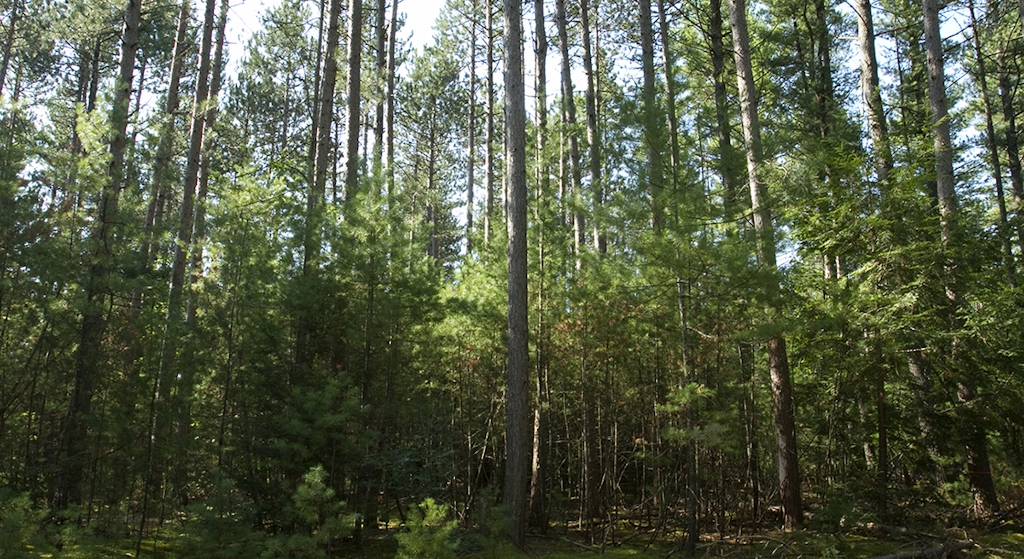Writing by Tinsley Hunsdorfer
Get to know a NEFF forest that specializes in a very large tree species—the Eastern White Pine, which can reach 150 feet in height—and habitat for a very small animal species, the imperiled and 15-inch long New England Cottontail.
Location: Francestown / Lyndeborough / New Boston, NH
Stretched along the winding South Branch of the Piscataquog River, NEFF’s Deland Memorial Forest has a lot to recommend it, from a wooded loop trail that provides hikers with beautiful water views and birdwatching opportunities, to a diverse combination of habitat types and a network of streams, rivers and wetlands.
What really makes Deland stand out, however, is how well white pine grows there, and that rare bunnies were once spotted—and may someday make a comeback—in the forest.
According to Deland’s management plan, “The property is an excellent example of a well-managed, natural white pine stand on glacial sands, gravels and till.”
Sandy, glacial outwash soils are a poor fit for agriculture, but are exactly what white pine trees need. Pair these soils with Exemplary Forest management, and you’ve got a productive, healthy forestland that naturally favors white pine. In Deland, more than 2.7 million board feet of timber have been harvested since 2000, and about 85 percent of it was white pine.
These harvests conducted to Exemplary Forestry standards are part of what makes Deland Memorial Forest a good fit for New England Cottontails, as the rabbits are well-adapted to the habitat that forms after harvests.
According to the U.S. Fish and Wildlife Service, “The New England cottontail prefers early successional forests, often called thickets, with thick and tangled vegetation. These young forests are generally less than 25 years old.” New England Cottontails are in decline, and loss of this particular habitat type is the primary cause. Since 1960, the species’ range has shrunk by 75 percent, and they are now listed as Vulnerable by the International Union for Conservation of Nature.
NEFF’s current management plan for Deland, compiled by forester Dennis McKenney, makes the rabbits’ habitat a top-level objective and records Dennis’ last sighting of a New England Cottontail at the property:
“Management Objective 2: Protect, and if possible, enhance the habitat for rare or endangered species. This specifically includes the New England Cottontail. (My last sighting of a NEC was in compartment F in the brush along the river in 1983 +/-, Dennis D. McKenney, 11/19/2015).”
Creating Deland Memorial Forest
In 1990, Susan Deland donated the Deland Memorial Forest to NEFF in memory of her husband, F. Stanton Deland. Mrs. Deland gave a conservation easement on the land to the Society for the Protection of New Hampshire Forests (SPNHF).
In 1994, Elizabeth Whitman generously donated 37 acres of abutting land in New Boston to the Deland Memorial Forest. In 1995, two abutting parcels were then purchased with major fundraising assistance from Mrs. Deland, SPNHF, New Hampshire Audubon, and the Piscataquog River Watershed Association. In 1997, Mrs. Deland protected an additional 256 acres with conservation easements. New Hampshire Audubon has also built a nature trail through part of Deland well-suited to viewing wildlife.
The remarkable cooperative effort that brought today’s Deland Memorial Forest together is just part of NEFF’s conservation impact in this area of south-central New Hampshire. NEFF’s 551-acre Townes Memorial Forest is just a couple of miles down the road, an additional six small NEFF forests are within a 10-mile radius of Deland, and the nearby Town of Milford permanently protected two of its existing town forests by donating a 646-acre conservation easement to NEFF in 2019.


